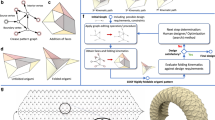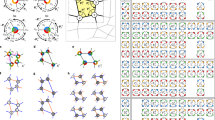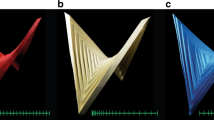Abstract
Origami describes rules for creating folded structures from patterns on a flat sheet, but does not prescribe how patterns can be designed to fit target shapes. Here, starting from the simplest periodic origami pattern that yields one-degree-of-freedom collapsible structures—we show that scale-independent elementary geometric constructions and constrained optimization algorithms can be used to determine spatially modulated patterns that yield approximations to given surfaces of constant or varying curvature. Paper models confirm the feasibility of our calculations. We also assess the difficulty of realizing these geometric structures by quantifying the energetic barrier that separates the metastable flat and folded states. Moreover, we characterize the trade-off between the accuracy to which the pattern conforms to the target surface, and the effort associated with creating finer folds. Our approach enables the tailoring of origami patterns to drape complex surfaces independent of absolute scale, as well as the quantification of the energetic and material cost of doing so.
This is a preview of subscription content, access via your institution
Access options
Subscribe to this journal
Receive 12 print issues and online access
$259.00 per year
only $21.58 per issue
Buy this article
- Purchase on Springer Link
- Instant access to full article PDF
Prices may be subject to local taxes which are calculated during checkout




Similar content being viewed by others
References
Demaine, E. & O’Rourke, J. Geometric Folding Algorithms: Linkages, Origami, Polyhedra (Cambridge Univ. Press, 2011).
Lang, R. Origami Design Secrets 2nd edn (CRC Press, 2011).
Miura, K. Method of Packaging and Deployment of Large Membranes in Space Report No. 618 (Institute of Space and Astronautical Science, 1985).
Kobayashi, H., Kresling, B. & Vincent, J. The geometry of unfolding tree leaves. Proc. R. Soc. Lond. B 265, 147–154 (1998).
Mahadevan, L. & Rica, S. Self-organized origami. Science 307, 1740 (2005).
Shyer, A. et al. Villification: how the gut gets its villi. Science 342, 212–218 (2013).
Bowden, N., Brittain, S., Evans, A. G., Hutchinson, J. & Whitesides, G. Spontaneous formation of ordered structures in thin films of metals supported on an elastomeric polymer. Nature 393, 146–149 (1998).
Rizzieri, R., Mahadevan, L., Vaziri, A. & Donald, A. Superficial wrinkles in stretched, drying gelatin films. Langmuir 22, 3622–3626 (2006).
Audoly, B. & Boudaoud, A. Buckling of a stiff film bound to a compliant substrate – Part III: Herringbone solutions at large buckling parameter. J. Mech. Phys. Solids 56, 2444–2458 (2008).
Wei, Z. Y., Guo, Z. V., Dudte, L., Liang, H. Y. & Mahadevan, L. Geometric mechanics of periodic pleated origami. Phys. Rev. Lett. 110, 215501 (2013).
Schenk, M. & Guest, S. D. Geometry of Miura-folded metamaterials. Proc. Natl Acad. Sci. USA 110, 3276–3281 (2013).
Silverberg, J. L. et al. Using origami design principles to fold reprogrammable mechanical metamaterials. Science 345, 647–650 (2014).
Silverberg, J. L. et al. Origami structures with a critical transition to bistability arising from hidden degrees of freedom. Nature Mater. 14, 389–393 (2015).
Waitukaitis, S., Menaut, R., Chen, B. & van Hecke, M. Origami multistability: from single vertices to metasheets. Phys. Rev. Lett. 114, 055503 (2015).
Tachi, T. Hangai prize papers for 2009: generalization of rigid-foldable quadrilateral-mesh origami. J. IASS 50, 173–179 (2009).
Gattas, M. & You, Z. Miura-based rigid origami: parametrizations of curved-crease geometries. J. Mech. Des. 136, 121404 (2014).
Tachi, T. Origamizing polyhedral surfaces. IEEE Trans. Vis. Comput. Graphics 16, 298–311 (2010).
Tachi, T. Freeform origami tessellations by generalizing Resch’s patterns. J. Mech. Des. 135, 111006 (2013).
Zhou, X., Wang, H. & You, Z. Design of three-dimensional origami structures based on vertex approach. Proc. R. Soc. A 471, 2184–2195 (2015).
Castle, T. et al. Making the cut: lattice kirigami rules. Phys. Rev. Lett. 113, 245502 (2014).
Sussman, D. et al. Algorithmic lattice kirigami: a route to pluripotent materials. Proc. Natl Acad. Sci. USA 112, 7449–7453 (2013).
Blees, M. K. et al. Graphene kirigami. Nature 524, 204–207 (2015).
Bern, M. W. & Hayes, B. The complexity of flat origami. Proc. 7th Annu (ACM-SIAM) Symp. Discrete Algorithms 175–183 (1996).
Kawasaki, T. Proc. 1st Int. Meeting Origami Sci. Technol. (ed. Huzita, H.) 229–237 (1989).
Chen, Y., Peng, R. & You, Z. Origami of thick panels. Science 349, 396–400 (2015).
Acknowledgements
We thank the Harvard Microrobotics Lab for help with laser cutting; J. Weaver and O. Ahanotu for help with measuring the stress-strain behaviour of origami hypars; and the Harvard MRSEC DMR 14-20570, NSF/JSPS EAPSI 2014 (L.H.D.), NSF DMS-1304211 (E.V.), Japan Science and Technology Agency Presto (T.T.) and the MacArthur Foundation (L.M.) for partial financial support.
Author information
Authors and Affiliations
Contributions
L.H.D., E.V. and L.M. conceived and designed the research, with later contributions from T.T.; L.H.D. conducted the simulations and built the models; L.H.D., E.V. and L.M. analysed the results and wrote the manuscript.
Corresponding author
Ethics declarations
Competing interests
L.H.D., E.V. and L.M. are co-inventors of the surface-fitting algorithm and design method, patent-pending.
Supplementary information
Supplementary Information
Supplementary Information (PDF 8125 kb)
Supplementary Movie 1
Supplementary Movie 1 (MOV 3764 kb)
Supplementary Movie 2
Supplementary Movie 2 (MOV 4138 kb)
Rights and permissions
About this article
Cite this article
Dudte, L., Vouga, E., Tachi, T. et al. Programming curvature using origami tessellations. Nature Mater 15, 583–588 (2016). https://doi.org/10.1038/nmat4540
Received:
Accepted:
Published:
Issue Date:
DOI: https://doi.org/10.1038/nmat4540
This article is cited by
-
Mechanical Metamaterials for Sensor and Actuator Applications
International Journal of Precision Engineering and Manufacturing-Green Technology (2024)
-
Decorated bacteria-cellulose ultrasonic metasurface
Nature Communications (2023)
-
Origamic metal-organic framework toward mechanical metamaterial
Nature Communications (2023)
-
An additive framework for kirigami design
Nature Computational Science (2023)
-
Approximating complex 3D curves using origami spring structures
Communications Engineering (2023)



